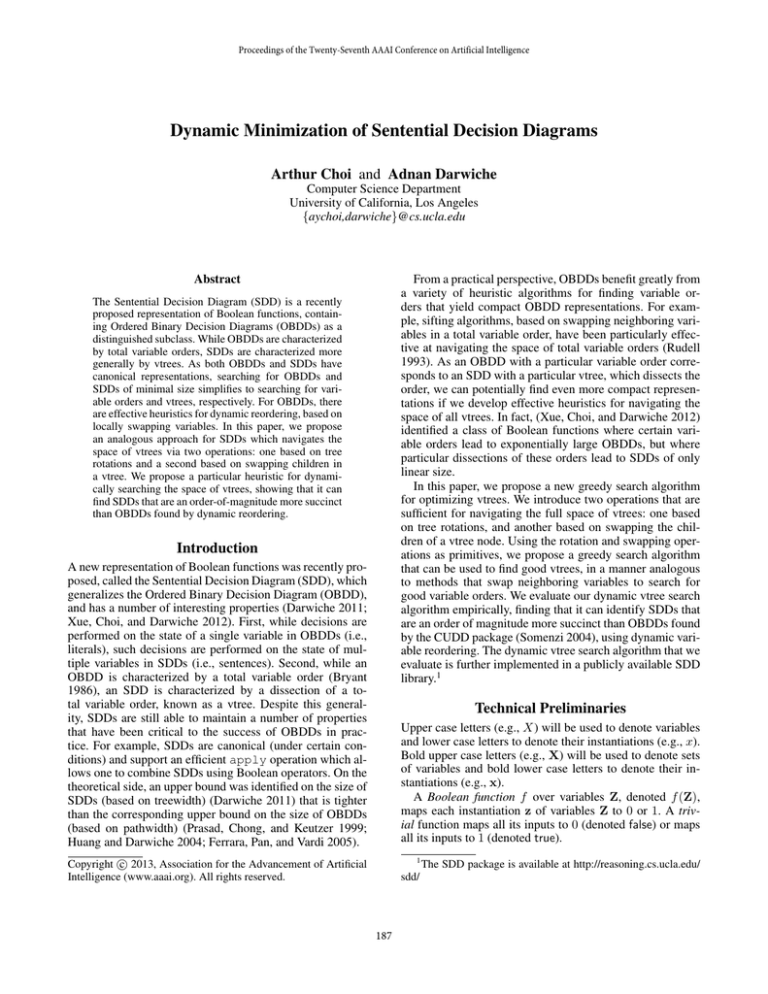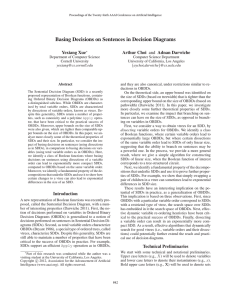
Proceedings of the Twenty-Seventh AAAI Conference on Artificial Intelligence
Dynamic Minimization of Sentential Decision Diagrams
Arthur Choi and Adnan Darwiche
Computer Science Department
University of California, Los Angeles
{aychoi,darwiche}@cs.ucla.edu
Abstract
From a practical perspective, OBDDs benefit greatly from
a variety of heuristic algorithms for finding variable orders that yield compact OBDD representations. For example, sifting algorithms, based on swapping neighboring variables in a total variable order, have been particularly effective at navigating the space of total variable orders (Rudell
1993). As an OBDD with a particular variable order corresponds to an SDD with a particular vtree, which dissects the
order, we can potentially find even more compact representations if we develop effective heuristics for navigating the
space of all vtrees. In fact, (Xue, Choi, and Darwiche 2012)
identified a class of Boolean functions where certain variable orders lead to exponentially large OBDDs, but where
particular dissections of these orders lead to SDDs of only
linear size.
In this paper, we propose a new greedy search algorithm
for optimizing vtrees. We introduce two operations that are
sufficient for navigating the full space of vtrees: one based
on tree rotations, and another based on swapping the children of a vtree node. Using the rotation and swapping operations as primitives, we propose a greedy search algorithm
that can be used to find good vtrees, in a manner analogous
to methods that swap neighboring variables to search for
good variable orders. We evaluate our dynamic vtree search
algorithm empirically, finding that it can identify SDDs that
are an order of magnitude more succinct than OBDDs found
by the CUDD package (Somenzi 2004), using dynamic variable reordering. The dynamic vtree search algorithm that we
evaluate is further implemented in a publicly available SDD
library.1
The Sentential Decision Diagram (SDD) is a recently
proposed representation of Boolean functions, containing Ordered Binary Decision Diagrams (OBDDs) as a
distinguished subclass. While OBDDs are characterized
by total variable orders, SDDs are characterized more
generally by vtrees. As both OBDDs and SDDs have
canonical representations, searching for OBDDs and
SDDs of minimal size simplifies to searching for variable orders and vtrees, respectively. For OBDDs, there
are effective heuristics for dynamic reordering, based on
locally swapping variables. In this paper, we propose
an analogous approach for SDDs which navigates the
space of vtrees via two operations: one based on tree
rotations and a second based on swapping children in
a vtree. We propose a particular heuristic for dynamically searching the space of vtrees, showing that it can
find SDDs that are an order-of-magnitude more succinct
than OBDDs found by dynamic reordering.
Introduction
A new representation of Boolean functions was recently proposed, called the Sentential Decision Diagram (SDD), which
generalizes the Ordered Binary Decision Diagram (OBDD),
and has a number of interesting properties (Darwiche 2011;
Xue, Choi, and Darwiche 2012). First, while decisions are
performed on the state of a single variable in OBDDs (i.e.,
literals), such decisions are performed on the state of multiple variables in SDDs (i.e., sentences). Second, while an
OBDD is characterized by a total variable order (Bryant
1986), an SDD is characterized by a dissection of a total variable order, known as a vtree. Despite this generality, SDDs are still able to maintain a number of properties
that have been critical to the success of OBDDs in practice. For example, SDDs are canonical (under certain conditions) and support an efficient apply operation which allows one to combine SDDs using Boolean operators. On the
theoretical side, an upper bound was identified on the size of
SDDs (based on treewidth) (Darwiche 2011) that is tighter
than the corresponding upper bound on the size of OBDDs
(based on pathwidth) (Prasad, Chong, and Keutzer 1999;
Huang and Darwiche 2004; Ferrara, Pan, and Vardi 2005).
Technical Preliminaries
Upper case letters (e.g., X) will be used to denote variables
and lower case letters to denote their instantiations (e.g., x).
Bold upper case letters (e.g., X) will be used to denote sets
of variables and bold lower case letters to denote their instantiations (e.g., x).
A Boolean function f over variables Z, denoted f (Z),
maps each instantiation z of variables Z to 0 or 1. A trivial function maps all its inputs to 0 (denoted false) or maps
all its inputs to 1 (denoted true).
1
c 2013, Association for the Advancement of Artificial
Copyright Intelligence (www.aaai.org). All rights reserved.
sdd/
187
The SDD package is available at http://reasoning.cs.ucla.edu/
6
6
C
⊤
2
0
B
6
¬B
5
2
1
3
A
D
2
(a) vtree
B A
¬B !
B ¬A
5
D C
A
¬A
B
0
A
4
C
A
6
5
5
C
¬D !
B ⊤
1
(b) graphical depiction of an SDD
B
¬B
4
D
4
Figure 1: Function f = (A ∧ B) ∨ (B ∧ C) ∨ (C ∧ D).
2
C
3
D
(a) right-linear
Consider a Boolean function f (X, Y) with disjoint sets
of variables X and Y. If
C D
(b) SDD
¬C !
1
0
(c) OBDD
Figure 2: A vtree, SDD and OBDD for (A ∧ B) ∨ (C ∧ D).
f (X, Y) = (p1 (X) ∧ s1 (Y)) ∨ . . . ∨ (pn (X) ∧ sn (Y))
then the set {(p1 , s1 ), . . . , (pn , sn )} is called an (X, Y)decomposition of the function f and each pair (pi , si ) is
called an element of the decomposition (Pipatsrisawat and
Darwiche 2010). The decomposition is further called an
(X, Y)-partition iff the pi ’s form a partition (Darwiche
2011). That is, W
pi 6= false for all i; and pi ∧ pj = false
for i 6= j; and i pi = true. In this case, each pi is called
a prime and each si is called a sub. An (X, Y)-partition
is compressed iff its subs are distinct, i.e., si 6= sj for
i 6= j (Darwiche 2011). Compression can always be ensured
by repeatedly disjoining the primes of equal subs. Moreover, a function f (X, Y) has a unique, compressed (X, Y)partition. Finally, the size of a decomposition, or partition, is
the number of its elements.
Note that (X, Y)-partitions generalize Shannon decompositions, which fall as a special case when X contains a
single variable. OBDDs result from the recursive application of Shannon decompositions, leading to decision nodes
that branch on the states of a single variable (i.e., literals). As
we show next, SDDs result from the recursive application of
(X, Y)-partitions, leading to decision nodes that branch on
the state of multiple variables (i.e., arbitrary sentences).
prime when the prime is a literal or a constant; otherwise, it
contains a pointer to a prime. Similarly, the right box contains a sub or a pointer to a sub. The three primes are decomposed recursively, but using the vtree rooted at v = 2.
Similarly, the subs are decomposed recursively, using the
vtree rooted at v = 5. This recursive decomposition process moves down one level in the vtree with each recursion,
terminating when it reaches leaf vtree nodes. The full SDD
for this example is depicted in Figure 1(b).
A decision node is said to be normalized for a vtree node
v iff it represents an (X, Y)-partition where X are the variables of v l and Y are the variables of v r . In Figure 1(b), each
decision node is labeled with the vtree node it is normalized
for. The size of an SDD is the sum of sizes attained by its
decision nodes. The SDD in Figure 1(b) has size 9.
SDDs obtained from the above process are called compressed iff the (X, Y)-partition computed at each step is
compressed. These SDDs may contain trivial decision nodes
which correspond to (X, Y)-partitions of the form {(>, α)}
or {(α, >), (¬α, ⊥)}. When these decision nodes are removed (by directing their parents to α), the resulting SDD is
called trimmed. Compressed and trimmed SDDs are canonical for a given vtree (Darwiche 2011)2 and we shall restrict
our attention to them in this paper.3 SDDs support a polytime apply operation, allowing one to combine two SDDs
using any Boolean operator (Darwiche 2011).4
OBDDs correspond to SDDs that are constructed using
right-linear vtrees (Darwiche 2011). A right-linear vtree is
one in which each left-child is a leaf; see Figure 2(a). When
using such vtrees, each constructed (X, Y)-partition is such
that X contains a single variable, therefore, corresponding
Sentential Decision Diagrams (SDDs)
Consider the full binary tree in Figure 1(a), which is known
as a vtree (v l and v r will be used to denote the left and right
children of a vtree node). Consider also the Boolean function f = (A ∧ B) ∨ (B ∧ C) ∨ (C ∧ D) over the same
variables. Node v = 6 is the vtree root. Its left subtree contains variables X = {A, B} and its right subtree contains
Y = {C, D}. Decomposing function f at node v = 6
amounts to generating an (X, Y)-partition of function f .
The unique compressed (X, Y)-partition here is
2
Given the usual assumption that the SDD has no isomorphic subgraphs, which can be easily ensured in practice using the
unique-node technique from the OBDD literature.
3
We will also assume reduced OBDDs, which are canonical for
a given variable order (Bryant 1986).
4
The polytime apply does not guarantee that the resulting
SDD is compressed, yet the apply we utilize in this work ensures
such compression as this has proved critical in practice.
{(A
∧ B}, |{z}
true ), (¬A
C ), (|{z}
¬B , |D {z
∧ C})}
| {z
| {z∧ B}, |{z}
prime
sub
prime
sub
prime
sub
This partition is represented by the root node of Figure 1(b).
This node, which is a circle, represents a decision node with
three branches. Each branch corresponds to one element
p s of the above partition. Here, the left box contains a
188
A
x
A
B
D
C
D
B
w
w
rr vnode(x)
c
a
a
Figure 3: Two vtrees that dissect order hA, B, C, Di.
b
a
OBDDs are characterized by total variable orders, so searching for a compact OBDD is done by navigating the space of
variable orders. Similarly, SDDs are characterized by vtrees,
so searching for a compact SDD will be done by navigating
the space of vtrees. In fact, the space of vtrees can be induced by considering the dissections of all variable orders.
a
b
(b)
As we shall see next, two vtree operations, called rotate and
swap, allow one to navigate the space of all vtrees.
Figure 4 illustrates two rotate operations on binary trees.
The first is right rotation, denoted by rr vnode(x), and the
second is left rotation, denoted by lr vnode(x). These are
inverse operations that cancel each other.
Rotations are known to be sufficient for enumerating all
binary trees over n nodes (Lucas, van Baronaigien, and
Ruskey 1993). Moreover, rotations are known to keep the
in-ordering of nodes in a binary tree invariant. Hence, using rotations, one can enumerate all dissections of a given
variable order. Figure 5 illustrates how to enumerate all dissections of variable orders over 4 variables, using rotations.
Figure 6 illustrates the swap operation on binary trees, denoted by swap vnode(x). This operation switches the left
and right children a and b. Upon performing a swap operation, a second swap will undo the first.
Importantly, rotations and swap allow one to explore all
vtrees. The proof rests on showing first how to swap two
neighboring variables, A and B, in the variable order of a
right-linear vtree. Suppose that we have such a vtree which
dissects the order hπ1 , A, B, π2 i, where π1 and π2 are suborders (possibly empty). We have two cases. First case:
A and B are children of the same parent x. In this case,
π2 must be empty and swap vnode(x) will generate a
vtree that dissects the order hπ1 , B, Ai. Second case: A has
parent w and B has parent x. In this case, w must also
be a parent of x. Moreover, the operations lr vnode(x),
swap vnode(w), and rr vnode(x) will generate a rightlinear vtree that dissects the order hπ1 , B, A, π2 i.
Suppose now that we have an arbitrary vtree dissecting
an order π1 and we wish to navigate to another vtree that
dissects a different order π2 . Using rotations only, we can
navigate to a right-linear vtree that dissects order π1 . By re-
over n variables.5 Hence, there are n! × Cn−1 = (2n−2)!
(n−1)! total vtrees over n variables. The following table gives a sense
of these search spaces in terms of the number of variables n.
5
120
14
1680
swap vnode(x)
x
Figure 6: Swapping the children of a vtree node x, back and
forth. Nodes a and b may represent leaves or subtrees.
Figure 3 depicts two dissections of the same variable order.
The search space over vtrees can then be characterized by
two dimensions: total variable orders and their dissections.
We have n! total variable orders over n variables. We also
(2n−2)!
have Cn−1 = n!(n−1)!
dissections of a total variable order
4
24
5
120
b
(a)
Definition 1 (Dissection) A vtree dissects a total variable
order π iff a left-right traversal of the vtree visits leaves
(variables) in the same order as π.
3
6
2
12
swap vnode(x)
x
Vtrees and Variable Orders
2
2
1
2
(b)
Figure 4: Rotating a vtree node x right and left. Nodes a, b,
and c may represent leaves or subtrees.
to a Shannon decomposition. In this case, primes are guaranteed to always be literals (i.e., a variable or its negation).
Moreover, decision nodes are guaranteed to be binary, leading to OBDDs (but with a different syntax); see Figure 2.
1
1
1
1
c
b
lr vnode(x)
(a)
n
# of orderings
# of dissections
# of vtrees
x
C
6
720
42
30240
It is well known that the choice of a total variable order
can lead to exponential changes in the size of a corresponding OBDD and, hence, SDD. Moreover, it is known that
different dissections of the same variable order can lead to
exponential changes in the SDD size (Xue, Choi, and Darwiche 2012). In fact, this last result is more specific: a rightlinear dissection of certain orders leads to an SDD/OBDD
of exponential size, yet some other dissection of the same
order leads to an SDD of only linear size. This only emphasizes the importance of searching for good vtrees.
Navigating the Space of Vtrees
When searching for a compact OBDD, the space of total
variable orders is usually navigated via swaps of neighboring variables since repeated application of this operation is
guaranteed to induce all total variable orders (Knuth 2005).
5
Cn−1 is the (n − 1)-st Catalan number, which is the number
of full binary trees with n leaves (Campbell 1984).
189
x
y
a
a
y
x
b
c
(a)
x
d
(b)
y
d
d
c
b
x
y
a
b
y
d
c
c
(c)
a
b
(d)
x
a
c
b
d
(e)
Figure 5: All 5 dissections of variable orders over 4 variables. Starting from vtree 5(a), one obtains vtrees 5(b), 5(c), 5(d), 5(e),
and then 5(a) again via the operations lr vnode(x), lr vnode(x), lr vnode(y), rr vnode(x) and rr vnode(y).
(CD, AB)-partition.8
A similar adjustment is needed when rotating vtree nodes.
Consider for example Figure 4 and suppose that A, B and
C are the variables appearing in the vtrees rooted at a, b
and c, respectively. Upon right rotation, all decision nodes
normalized for vtree node x in Figure 4(a) must be adjusted so they become normalized for vtree node w in Figure 4(b). That is, these decision nodes, which correspond to
(AB, C)-partitions, must be adjusted so they correspond to
equivalent (A, BC)-partitions. Left rotation calls for a similar adjustment, requiring one to convert (A, BC)-partitions
into equivalent (AB, C)-partitions.9
Adjusting an SDD in response to a vtree change is then a
matter of converting between equivalent (X, Y)-partitions.
We will discuss these conversions next and show how they
can be implemented using apply and negate.
The simplest conversion is from an (A, BC)-partition
to an (AB, C)-partition (left rotation). Consider then a
compressed (A, BC)-partition {(a1 , bc1 ), . . . , (an , bcn )},
where each sub bci has the compressed (B, C)-partition
{(bi1 , ci1 ), . . . , (bimi , cimi )}. One can then show that {(ai ∧
bij , cij ) | i = 1, . . . , n and j = 1, . . . , mi } is an equivalent
(AB, C)-partition, which may not be compressed. This partition can be computed using apply to conjoin existing
SDD nodes ai and bij . Moreover, it can be compressed by
disjoining the primes of equal subs, again, using apply.
The next two conversions require one to compute the
Cartesian product of formula-partitions. In particular, suppose that {α1 , . . . , αn } is a formula-partition (i.e., αi ∧αj =
false for i 6= j, and α1 ∨ . . . ∨ αn = true). Suppose further
that {β1 , . . . , βm } is another formula-partition. The Cartesian product is defined as {αi ∧ βj | αi ∧ βj 6= false, i =
1, . . . , n, j = 1, . . . , m}. This product is also a formulapartition and can be computed using apply.
To see how to adjust an SDD for a swap, consider a compressed (X, Y)-partition {(p1 , s1 ), . . . , (pn , sn )}. We can
construct the equivalent, compressed (Y, X)-partition as
peated application of the technique discussed above, we can
navigate to another right-linear vtree that dissects order π2 .
We can now navigate to any other vtree that dissects order
π2 , using rotations only. Hence, the rotate and swap operations are complete for navigating the space of all vtrees.
The SDD Package
The rest of our discussion will need to make reference to our
publicly available implementation, the SDD Package. The
high-level interface of this package and some of its architecture is highly influenced by the CUDD package for OBDDs.
In particular, it provides the following primitive operations:
apply for conjoining or disjoining two SDDs,6 negate
for negating an SDD,7 lr vnode(x), swap vnode(x),
and rr vnode(x) for performing the corresponding operations on vtree nodes and adjusting any corresponding
SDDs accordingly (more on this next). The package employs constructs that are similar to those of the CUDD package, such as managers, unique-tables, computation caches,
and a garbage collector based on reference counts. Our SDD
package exposes all these primitives together with source
code for two algorithms that we discuss later: a vtree search
algorithm, and a CNF-to-SDD compiler that makes dynamic
calls to our vtree search algorithm. First, however, we discuss the process of adjusting an SDD after the underlying
vtree has been changed by rotation or swapping.
Adjusting SDDs under Rotate and Swap
Consider the SDD in Figure 1 and its corresponding vtree.
Consider in particular the decision node normalized for vtree
node 6, which corresponds to a compressed (AB, CD)partition. If we swap vtree node 6, this decision node must be
adjusted so it corresponds to an equivalent and compressed
6
The apply operation is based on the following result. If
◦ is a Boolean operator, and we have two compressed (X, Y)partitions {(pi , si )}i and {(qj , rj )}j for functions f and g, then
{(pi ∧ qj , si ◦ rj ) | pi ∧ qj 6= false} is an (X, Y)-partition for
function f ◦ g, although it may not be compressed. Successively
disjoining the primes of equal subs yields a compressed partition.
7
The negate operator is based on the following result. If
{(pi , si )}i is the compressed (X, Y)-partition for function f , then
{(pi , ¬si )}i is the compressed (X, Y)-partition for ¬f .
8
This adjustment may lead to the creation of new decision
nodes normalized for the descendants of vtree node 6. It may also
lead to removing references to existing decisions nodes.
9
Note that decision nodes normalized for vtree node w in Figure 4(a) continue to be normalized for w after right rotation. Similarly, decision nodes normalized for vtree node x in Figure 4(b)
continue to be normalized for x after left rotation.
190
follows. We first compute the Cartesian product of formulapartitions {s1 , ¬s1 }, . . . , {sn , ¬sn }, which is guaranteed to
contain the primes of our sought (Y, X)-partition. Each
prime in this product must correspond to a conjunction of
the form c1 ∧ . . . ∧ cn where each ci equals si or ¬si . Let
I be theWindices i of all ci = si . The corresponding sub
is then i∈I pi . One can show that the described (Y, X)decomposition is a compressed (Y, X)-partition and equivalent to the original (X, Y)-partition. Moreover, it can be
directly computed using apply and negate.
Finally, we consider the adjustment of an SDD due to
a right rotation. Consider a compressed (AB, C)-partition
{(ab1 , c1 ), . . . , (abn , cn )}, where each prime abi has the
compressed (A, B)-partition {(ai1 , bi1 ), . . . , (aimi , bimi )}.
We first compute the Cartesian product of formula-partitions
{a11 , . . . , a1m1 }, . . . , {an1 , . . . , anmn }, which is guaranteed to contain the primes of our sought (A, BC)-partition.
Each prime in this product corresponds to a conjunction of
the
Wn form a1j1 ∧ . . . ∧ anjn . The corresponding sub is then
i=1 biji ∧ ci . One can show that the described (A, BC)decomposition is an (A, BC)-partition and equivalent to the
original (AB, C)-partition, but may not be compressed. It
can also be computed and compressed using apply.
We close this section by a comparison to the process of
adjusting OBDDs after swapping two neighboring variables
in a total variable order. Such adjustments are known to have
a bounded impact on the OBDD size as it only involves
a local adjustment to the OBDD structure (Rudell 1993).
Hence, when searching for a total variable order using variable swaps, each move in the search space is guaranteed to
be efficient. The situation is different for vtrees. In particular, each move in this space (rotation or swap) involves nontrivial changes to the SDD structure. In fact, (Xue, Choi, and
Darwiche 2012) has shown that swapping the children of a
vtree node can lead to an exponential change in the SDD
size. Hence, while swapping two variables in a total variable
order can have a predictable, but conservative, effect on the
OBDD size, swapping a single pair of children in a vtree can
potentially obtain a significantly more succinct SDD in one
operation. From this perspective, the potentially expensive
swap operation for vtrees allows one to make large jumps in
the search space, whereas the relatively inexpensive swap
operation in total variable orders may need to be applied
many times before achieving the same effect.
v
v
y
x
a
b
c
d
(a) vtree fragment
a
v
y
x
b
(b) l-vtree
y
x
c
d
(c) r-vtree
Figure 7: A vtree fragment.
rooted at v. The proposed search algorithm attempts to navigate through all 24 variations using a pre-stored sequence
of rotations and swaps which is guaranteed to cycle through
them, returning back to the original l-vtree or r-vtree that we
start with. The algorithm then chooses the one variation with
smallest SDD size10 and navigates back to that variation. At
this point, the algorithm is said to have completed a single
pass on the sub-vtree rooted at v.
If a pass changes the SDD size by more than a given
threshold (set to 1% in our experiments), another pass is
made. That is, another call is made on vtree node v with
corresponding recursive calls on its children. Otherwise, the
algorithm terminates.
We will now explain the term “attempt” used earlier. The
SDD package allows the user to specify time or size limits for the rotate and swap operations. If these limits are
exceeded while the operation is taking place, the operation
fails and the state of the vtree and corresponding SDD are
rolled back to how they existed before the operation started.
In our experiments, we use size limits but not time limits.
Thus, the algorithm may not navigate through all 24 variations described above if the size limit is exceeded. We use
a size limit of 25% for swap, causing the operation to fail if
swapping a vtree node leads to increasing the SDD size by
more than 25%. The size limits for rotations are set to 75%.
Dynamic Compilation of CNFs into SDDs
One typically generates an SDD incrementally and tries to
minimize it if its size starts growing too much during the
generation process. Consider for example the process of
compiling a CNF into an SDD. One typically starts with
an initial vtree, compiles each clause of the CNF into a
corresponding SDD, and then conjoins these SDDs (using
apply). Since these conjoin operations take place in sequence, the final SDD is then said to be constructed incrementally. Typically, if a conjoin operation grows the SDD
size by a certain factor, one tries to search for a better vtree
before proceeding with the remaining conjoin operations.
This would be the typical usage of the search algorithm
developed in the previous section. This would also be the
proper context for evaluating its effectiveness — which is
also the context usually used for evaluating dynamic ordering heuristics for OBDDs. The experiments of the next section are thus conducted in the context of compiling CNFs to
SDDs while using dynamic vtree search as discussed above.
Searching for a Good Vtree
Our search algorithm assumes an existing vtree and a corresponding SDD. The algorithm can be called on any vtree
node v and it will try to minimize the SDD size by searching
for a new sub-vtree to replace the one currently rooted at v.
The algorithm first makes recursive calls on the children
of vtree node v. It then considers v and the two levels below it (when applicable) as shown in Figure 7(a). One can
isolate two vtree fragments in this figure: the l-vtree in Figure 7(b) and the r-vtree in Figure 7(c). The l-vtree is just one
of 12 vtrees over leaves a, b and y. Similarly, the r-vtree is
just one of 12 vtrees over leaves x, c and d. Each one of
these 24 vtrees leads to a variation on the original sub-vtree
10
We break ties by preferring smaller decision node counts and
better vtree balance.
191
Suppose we are given a CNF ∆ as a set of clauses and a
vtree for the variables of ∆. Suppose further that each clause
c is assigned to the lowest vtree node v which contains the
variables of clause c (node v is unique). Our algorithm for
compiling CNFs takes this labeled vtree as input.
The initial vtree structure provides a recursive partitioning of the CNF clauses, with each node v in the vtree hosting a set of clauses ∆v . The algorithm recursively compiles the clauses hosted by nodes in the sub-vtrees rooted at
the children of v. This leads to two SDDs corresponding to
these children. The algorithm conjoins these two SDDs using apply. It then iterates over the clauses hosted at node
v, compiling each into an SDD,11 and conjoining the result
with the existing SDD. If this last conjoin operation grows
the SDD size by more than a certain factor (since the last call
to vtree search), the vtree search algorithm is called again on
node v.12 In our experiments, we set this factor to 20%. We
also visit the clauses hosted by node v according to their
length, with shorter clauses visited first.
not too surprising as it has been previously observed that
even a random dissection of total variable orders tend to
lead to SDDs that are more compact than the corresponding OBDDs (Darwiche 2011). We also note that in 11 of the
benchmarks we evaluated, we observed at least an order-ofmagnitude improvement in size. This suggests that the theoretical properties of SDDs discussed by (Xue, Choi, and
Darwiche 2012) can also be realized in practice. Moreover,
in 4 instances, SDD compilation succeeded and OBDD compilation failed. In 2 instances, OBDD compilation succeeded
and SDD compilation failed.
Next, our second observation is that in many benchmarks, our dynamic compilation algorithm was faster than
CUDD’s, and in 7 cases, orders-of-magnitude faster. This
is more evident in the more challenging benchmarks with
larger compilations. This is particularly interesting since dynamic vtree search uses more expensive, yet more powerful,
operations for navigating its search space, in comparison to
the efficient, but less powerful, operation used for navigating
total variable orders.
Experimental Results
We evaluate our algorithm on CNFs of combinational circuits used in the CAD community, and in particular, from
the LGSynth89, iscas85 and iscas89 benchmark
sets. We use the CUDD package to compile CNFs to OBDDs, using dynamic variable reordering and default parameters.13 We further conjoin clauses according to the procedure from the previous section, assuming a right-linear vtree
induced by the natural variable order of the CNF.14 For our
SDD compiler, we initially used a balanced vtree dissecting the natural variable order of the CNF. Experiments on
the LGSynth89 suite were performed on a 2.67GHz Intel Xeon x5650 CPU with access to 12GB RAM. Experiments on the iscas85 and iscas89 suites were performed on a 2.83GHz Intel Xeon x5440 CPU with access
to 8GB RAM. We excluded benchmarks from these suites
if (1) both OBDD and SDD compilations failed given a two
hour time limit, or (2) if the resulting SDD has a size of less
than 2,000, which we consider too trivial.
Our experimental results in Table 1 call for a number of
observations. First, the SDD turns out to be a more compact representation in all benchmarks successfully compiled
by both the SDD and OBDD compilers. This is perhaps
We see similar results in Table 2, where as a preprocessing step, we applied MINCE to our CNFs, to find
an initial static variable ordering for CUDD (Aloul, Markov,
and Sakallah 2004). For SDDs, we initially used a balanced
vtree dissecting the same order. We observe, in general,
that using MINCE orderings improves the resulting OBDD
and SDD compilations, further allowing both to successfully
compile cases where they failed to before. We find that SDD
compilations, in 4 cases, can still be an order-of-magnitude
more succinct. Moreover, there were 5 cases where SDD
compilation succeeded and OBDD compilation failed. In total, across all experiments, there were 15 cases where the
SDD compilation was at least an order-of-magnitude more
succinct than the OBDD compilation. Moreover, there were
9 cases where SDD compilation succeeded and OBDD compilation failed, and there were 3 cases where OBDD compilation succeeded and SDD compilation failed.
We finally ask: Is it the total variable orders discovered
by our vtree search algorithm, or the particular dissection
of these orders, which is responsible for these favorable results? To help answer this question, we extracted the variable order embedded in each discovered vtree and then constructed an OBDD using that order. The sizes of these OBDDs are reported in the column titled “r. linear SDD.” In
a number of cases, the resulting OBDDs are much worse
than the OBDDs found by CUDD. These cases show emphatically that dissection is what explains the improvements
(i.e., making decisions on arbitrary sentences instead of literals). That is, by simply dissecting these OBDDs, we can
obtain even more succinct SDDs, even if we dissect an
OBDD with a poor variable order. In other cases, the resulting OBDD is comparable or more succinct than the OBDD
found by CUDD. Interestingly, this suggests that the vtree
search algorithm that we proposed can also find effective
variable orderings, in comparison to more specialized reordering heuristics.
11
The SDD package provides a primitive that returns an SDD for
a given literal. Hence, one can easily compile a clause into an SDD
by disjoining the SDDs corresponding to its literals, using apply.
12
In principle, a clause hosted at node v, that has not yet been
conjoined, could possibly be re-assigned to a lower node after a
vtree search is invoked. However, we would have already visited
these nodes during the compilation algorithm, so we just finish conjoining those clauses at node v.
13
We used heuristic CUDD REORDER SYMM SIFT, which is
symmetric sifting (Panda, Somenzi, and Plessier 1994). We also
invoked sifting in a post-processing step, after compilation.
14
In an earlier version of this paper, we assumed a natural ordering of the clauses, which produced worse results for OBDD compilations. Moreover, these earlier evaluations always pre-processed
the CNF using MINCE. Here, we consider compilation with and
without MINCE, leading to a more revealing comparison.
192
CNF
9symml
C432
C432 out
apex7
b9
c8
cht
comp
count
example2
f51m
frg1
lal
mux
my adder
pm1
sct
ttt2
unreg
vda
z4ml
s298
s344
s349
s382
s386
s400
s420
s444
s510
s526
s526N
s641
s713
s832
s838.1
s838
c432
c499
c1355
size
OBDD
SDD
54,230
—
—
9,469
228,036
5,768
148,876
8,191
136,440
8,813
2,456,186
22,179
12,296
4,924
2,774
2,211
55,312
3,359
34,456
8,361
10,186
3,090
358,216
81,133
31,082
6,139
3,052
2,058
19,632
2,959
2,650
2,107
9,954
8,094
244,598
14,872
20,338
3,092
43,626
—
3,112
2,311
10,122
3,758
39,646
5,769
10,048
3,319
17,974
3,520
28,560
7,162
6,088
3,520
17,744
4,180
10,472
4,024
26,892
7,136
129,662
9,446
107,334
6,649
517,688
10,164
—
11,386
125,652
23,028
52,934
9,387
312,470
14,458
689,092
9,922
— 387,400
— 325,193
OBDD
SDD
—
—
39.53
18.18
15.48
110.74
2.50
1.25
16.47
4.12
3.30
4.42
5.06
1.48
6.63
1.26
1.23
16.45
6.58
—
1.35
2.69
6.87
3.03
5.11
3.99
1.73
4.24
2.60
3.77
13.73
16.14
50.93
—
5.46
5.64
21.61
69.45
—
—
time
OBDD
SDD
10.64
—
—
24.63
178.07
6.54
164.16
46.07
4,619.65
27.31
5,047.04 1,289.80
1.39
9.56
3.30
5.65
1,719.99
5.37
247.38
127.27
0.47
2.65
60.16
169.42
19.23
29.40
0.33
1.04
75.14
4.68
0.45
1.53
3.60
332.45
703.63
139.61
4.97
2.78
4,557.45
—
0.12
1.21
2.31
3.43
9.61
5.67
3.99
4.10
14.25
4.13
10.46
11.39
8.55
4.43
16.25
5.56
51.51
6.21
157.95
96.13
49.73
53.14
136.64
20.61
1,434.14
18.09
—
26.46
659.46
252.79
442.04
41.16
1,536.27
776.06
1,416.69
71.93
— 1,476.44
— 2,550.90
OBDD
SDD
—
—
27.23
3.56
169.16
3.91
0.15
0.58
320.30
1.94
0.18
0.36
0.65
0.32
16.06
0.29
0.01
5.04
1.79
—
0.10
0.67
1.69
0.97
3.45
0.92
1.93
2.92
8.29
1.64
0.94
6.63
79.28
—
2.61
10.74
1.98
19.70
—
—
r. linear
SDD
—
88,512
36,370
120,414
186,722
307,402
38,492
4,664
7,902
58,806
10,612
750,776
107,424
5,924
8,416
8,688
53,206
79,768
5,814
—
6,160
28,370
39,778
18,346
12,412
33,938
13,454
11,302
74,816
30,196
92,394
45,230
229,650
291,816
255,916
30,926
119,962
96,380
—
—
OBDD
SDD
—
—
6.27
1.24
0.73
7.99
0.32
0.59
7.00
0.59
0.96
0.48
0.29
0.52
2.33
0.31
0.19
3.07
3.50
—
0.51
0.36
1.00
0.55
1.45
0.84
0.45
1.57
0.14
0.89
1.40
2.37
2.25
—
0.49
1.71
2.60
7.15
—
—
Table 1: OBDD and SDD compilations over LGSynth89, iscas85 and iscas89 suites. Missing entries indicate a failed
compilation, either an out-of-memory, or a timeout of 2 hours. OBDD/SDD columns report relative improvement (in size or
time). Bolded text indicate cases where time/size improvements were an order-of-magnitude or more, or if SDD compilation
succeeded and OBDD compilation failed. Reported sizes are based on SDD notation. Reported times are in seconds.
193
CNF
9symml
C432
C499
C1355
C1908
alu2
alu4
apex6
apex7
b9
c8
cht
count
example2
f51m
frg1
frg2
lal
mux
my adder
sct
term1
ttt2
unreg
vda
x4
size
OBDD
SDD
49,576
14,057
169,984
9,063
—
240,253
—
723,549
— 3,216,974
38,298
11,513
267,562
—
—
283,174
33,124
6,509
50,270
10,362
54,674
13,257
8,764
4,012
13,938
3,157
15,044
7,742
8,030
3,149
374,988
107,447
—
255,136
7,216
5,229
3,366
2,061
1,728
2,341
7,154
6,948
1,484,518
128,152
36,428
13,331
39,590
3,168
44,568
13,659
595,160
27,720
OBDD
SDD
3.53
18.76
—
—
—
3.33
—
—
5.09
4.85
4.12
2.18
4.41
1.94
2.55
3.49
—
1.38
1.63
0.74
1.03
11.58
2.73
12.50
3.26
21.47
time
OBDD
SDD
6.05
35.17
69.71
52.54
— 1,033.67
— 1,494.54
— 5,676.72
8.89
90.11
5,982.86
—
— 1,746.71
2.38
5.51
8.95
5.16
8.07
10.09
0.31
1.92
1.89
1.94
2.48
6.80
0.32
1.34
51.84
164.10
— 6,591.69
1.01
3.09
0.06
0.57
0.06
1.15
1.63
7.84
2,209.67
873.59
6.61
14.83
4.22
18.06
599.67
125.72
961.90
47.46
OBDD
SDD
0.17
1.33
—
—
—
0.10
—
—
0.43
1.73
0.80
0.16
0.97
0.36
0.24
0.32
—
0.33
0.11
0.05
0.21
2.53
0.45
0.23
4.77
20.27
r. linear
SDD
102,596
110,148
18,369,492
—
—
108,250
—
—
61,878
486,484
142,138
11,262
8,262
43,618
9,674
772,108
—
19,062
10,090
2,822
41,564
3,930,362
72,268
8,232
—
2,091,326
OBDD
SDD
0.48
1.54
—
—
—
0.35
—
—
0.54
0.10
0.38
0.78
1.69
0.34
0.83
0.49
—
0.38
0.33
0.61
0.17
0.38
0.50
4.81
—
0.28
Table 2: OBDD and SDD compilations over the LGSynth89 suite, using MINCE variable orders. See also Table 1.
Conclusion
manipulation. J. UCS 10(12):1562–1596.
Bryant, R. E. 1986. Graph-based algorithms for Boolean function
manipulation. IEEE Transactions on Computers C-35:677–691.
Campbell, D. M. 1984. The computation of Catalan numbers.
Mathematics Magazine 57(4):195–208.
Darwiche, A. 2011. SDD: A new canonical representation of
propositional knowledge bases. In IJCAI, 819–826.
Ferrara, A.; Pan, G.; and Vardi, M. Y. 2005. Treewidth in verification: Local vs. global. In LPAR, 489–503.
Huang, J., and Darwiche, A. 2004. Using DPLL for efficient
OBDD construction. In SAT.
Knuth, D. E. 2005. The Art of Computer Programming, Volume
4, Fascicle 2: Generating All Tuples and Permutations. AddisonWesley Professional.
Lucas, J. M.; van Baronaigien, D. R.; and Ruskey, F. 1993. On rotations and the generation of binary trees. J. Algorithms 15(3):343–
366.
Panda, S.; Somenzi, F.; and Plessier, B. 1994. Symmetry detection
and dynamic variable ordering of decision diagrams. In ICCAD,
628–631.
Pipatsrisawat, K., and Darwiche, A. 2010. A lower bound on the
size of decomposable negation normal form. In AAAI.
Prasad, M. R.; Chong, P.; and Keutzer, K. 1999. Why is ATPG
easy? In DAC, 22–28.
Rudell, R. 1993. Dynamic variable ordering for Ordered Binary
Decision Diagrams. In ICCAD, 42–47.
Somenzi, F. 2004. CUDD: CU decision diagram package. http:
//vlsi.colorado.edu/∼fabio/CUDD/.
Xue, Y.; Choi, A.; and Darwiche, A. 2012. Basing decisions on
sentences in decision diagrams. In AAAI, 842–849.
This paper provides the elements necessary for making the
sentential decision diagram (SDD) a viable tool in practice
— at least in comparison to the influential OBDD. In particular, the paper shows how one may dynamically search
for vtrees that attempt to minimize the size of constructed
SDDs. Our contributions include: (1) a characterization of
the vtree search space as dissections of total variable orders; (2) an identification of two vtree operations that allow one to navigate this search space; (3) corresponding operations for adjusting an SDD due to vtree changes; (4) a
CNF to SDD compiler based on dynamic vtree search; and
(5) a publicly available SDD package that embodies all of
the previous elements. Empirically, our results show that our
proposed approach for constructing SDDs can lead to orderof-magnitude improvements in time and space over similar
approaches for constructing OBDDs. By releasing our SDD
package to the public, we hope that the community will have
the necessary infrastructure for building even more effective
search algorithms in the future.
Acknowledgments
This work has been partially supported by ONR grant
#N00014-12-1-0423, NSF grant #IIS-1118122, and NSF
grant #IIS-0916161.
References
Aloul, F. A.; Markov, I. L.; and Sakallah, K. A. 2004. Mince: A
static global variable-ordering heuristic for SAT search and BDD
194










